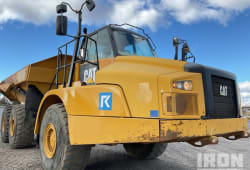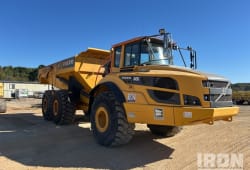How to Launch a Trucking Business?
9 Min read
)
October 7, 2023
Launching a successful trucking business can be a rewarding endeavor, but it demands meticulous preparation and strategy. In this comprehensive guide, we'll walk you through the crucial 10 steps to initiate and thrive in the trucking industry. From defining your vision and crafting a solid business plan to navigating legal requirements, selecting the right equipment, securing financing, building your team, and optimizing routes, this roadmap provides invaluable insights. Additionally, we'll delve into leveraging technology, ensuring safety and compliance, and scaling your business effectively. Follow these steps diligently to embark on your journey toward a prosperous trucking venture.
:format(webp))
Step 1: Define Your Trucking Business Vision
The foundation of your trucking business lies in a well-defined vision. Start by articulating your business goals and objectives. Are you aiming for rapid expansion or steady growth? Next, identify your target markets - which industries or clients do you intend to serve? Knowing your ideal customer base is key to tailoring your services effectively.
One of the critical decisions is determining the scope of your operations. Will you specialize in local deliveries, regional hauls, or long-distance transportation? Each option comes with its unique set of challenges and opportunities, so it's crucial to align your choice with your capabilities and market demand.
By establishing a clear vision for your trucking business, you lay the foundation for strategic planning and decision-making in the subsequent steps. Your vision will serve as a morale booster, helping you stay on course as you navigate the complexities of the trucking industry.
Step 2: Establish Routes and Contracts
Once you've defined your trucking business's vision, the next critical step is to identify profitable routes and establish solid contracts with shippers and clients. Efficient route planning is essential for optimizing fuel efficiency, minimizing downtime, and maximizing profitability. Consider factors such as distance, traffic patterns, and potential return loads when selecting your routes.
Building strong relationships with shippers and clients is paramount for securing consistent business. Reach out to potential partners and negotiate mutually beneficial agreements. Ensure that contracts outline payment terms, delivery schedules, and any special requirements. Reliability and transparency are key to maintaining trust in these relationships.
Additionally, consider diversifying your client base to reduce dependency on a single source of income. A diverse portfolio of clients can help mitigate risks and provide stability to your trucking operations.
By proactively managing routes and fostering strong partnerships through well-structured contracts, you'll position your trucking business for sustainable growth and profitability in a competitive industry.
Step 3: Secure Funding
Securing the essential capital to launch your trucking business is a pivotal step in your entrepreneurial journey. It involves obtaining the financial resources necessary to acquire trucks, cover insurance expenses, and manage day-to-day operational costs. To start, establish a clear budget that includes all aspects of your trucking venture, from vehicle purchases and insurance premiums to permits, fuel, maintenance, and driver salaries. With this comprehensive financial roadmap in place, you can better determine your funding needs.
Next, explore various financing options to meet those needs. Consider traditional sources like bank loans or government-backed Small Business Administration (SBA) loans. Additionally, investigate potential grants and the possibility of attracting investors who believe in your business concept. Each funding source comes with its unique requirements and terms, so choose the one that aligns well with your financial situation and business plan.
Finally, it's essential to develop an effective financial plan that showcases your ability to manage funds responsibly, repay loans, and generate profits. Effective financial management, coupled with good budgeting, will enable you to make the most of the resources you secure. In essence, securing funding is a pivotal step that develops the financial backbone of your trucking business, setting the stage for successful operations.
Step 4: Obtain the Necessary Licenses and Permits
Compliance with different types of federal, state, and local regulations is an indispensable aspect of establishing a legal and smoothly functioning trucking business. The initial step is obtaining the necessary licenses, permits, and insurance coverage that your operation demands. Ensuring your drivers possess the appropriate Commercial Driver's License (CDL) for the vehicles they will operate is the first crucial element. Additionally, depending on the scope of your business, you may need operating authority from the Federal Motor Carrier Safety Administration (FMCSA), including Motor Carrier (MC) numbers and the Unified Carrier Registration (UCR). Investigate and secure any state or local permits relevant to your specific routes and activities. Adequate insurance coverage, encompassing liability, cargo, and physical damage insurance, is indispensable for safeguarding your business and clients.
Depending on your operations, you may also require an International Registration Plan (IRP) registration and an International Fuel Tax Agreement (IFTA) permit for interstate travel and fuel tax management. In cases involving hazardous materials transport, ensure drivers possess the requisite Hazardous Materials Endorsement. Given the complexity of regulatory requirements, it's advisable to seek guidance from legal and industry experts to guarantee comprehensive compliance, safeguarding your trucking business from legal entanglements and potential liabilities.
Step 5: Purchase or Lease Trucks and Equipment
The foundation of your trucking business relies on the reliability of your trucks and equipment. This step demands thoughtful investment, aligning your choices with both your budget and your long-term business aspirations. It begins with a thorough assessment of your specific operational needs, encompassing considerations like load capacity, fuel efficiency, and maintenance costs. Crucially, you must decide between buying and leasing equipment. Purchasing offers the advantage of long-term ownership but often necessitates a significant upfront capital outlay. On the other hand, leasing provides flexibility and lower initial costs but may result in higher monthly payments over time.
Furthermore, you must decide whether to choose new or used vehicles, weighing warranty benefits against cost-effectiveness. Exploring financing options, such as bank loans or commercial vehicle financing is vital for acquiring the necessary assets. Additionally, establish a rigorous maintenance schedule and ensure all vehicles and equipment comply with safety and regulatory standards. By making well-informed decisions regarding your fleet, you can not only enhance operational efficiency but also manage costs effectively, setting your trucking business on a path to success.
Step 6: Hire and Train Drivers
Building a competent team of drivers is important for the success of your trucking business. Start by recruiting qualified individuals with clean driving records who align with your company's values. Prioritize candidates who possess the necessary licenses, endorsements, and relevant experience.
Once your team is in place, invest in comprehensive training programs that cover safety protocols, regulatory compliance, and company policies. Ensure drivers are well-versed in handling emergencies, maintaining equipment, and adhering to transportation regulations. Continuous education and periodic safety reviews are essential to maintaining a high standard of professionalism and safety among your drivers. A well-trained and motivated workforce contributes significantly to the efficiency and reputation of your trucking business.
Step 7: Market and Promote Your Trucking Business
To establish a strong foothold in the trucking industry, effective marketing and promotion are essential. Begin by building a robust online presence, including a professional website and active social media profiles. Utilize these platforms to showcase your services, expertise, and client testimonials.
Networking is equally crucial. Connect with industry professionals, shippers, and logistics partners to expand your client base and gain valuable insights. Attend industry events and join relevant associations to build your presence.
Develop a targeted marketing strategy that may include online advertising, email marketing, and content creation. Highlight your unique selling points and emphasize reliability, safety, and efficiency to attract potential clients. Successful marketing efforts can significantly boost your trucking business's visibility and growth.
Step 8: Manage Your Finances and Operations
Effective financial management is an important aspect of a successful trucking business. Implement robust practices to monitor expenses, revenue, and profitability closely. Create a comprehensive budget that includes all operational costs, including fuel, maintenance, insurance, and salaries. Regularly review and adjust your budget as needed to ensure financial stability.
Simultaneously, maintain a track of daily operations. Monitor routes, schedules, and driver performance to optimize efficiency and minimize downtime. Implement technology solutions for tracking and managing logistics. Stay proactive in addressing any operational challenges promptly to maintain a high standard of service. By effectively managing both your finances and daily operations, you'll ensure the long-term sustainability and profitability of your trucking business.
Step 9: Invest in Technology and Logistics
In the modern trucking industry business, technology is a driving force behind efficiency and competitiveness. Invest in cutting-edge solutions to streamline your operations. Utilize route optimization software to minimize fuel consumption and maximize on-time deliveries. Implement fleet tracking systems for real-time monitoring of vehicle locations and performance. Equip your drivers with mobile communication tools for seamless coordination and updates.
Moreover, focus on enhancing logistics management. Efficiently plan and manage your shipments, minimize idle time, and coordinate loads effectively. Leverage technology to gain a competitive edge and stay agile in a rapidly evolving industry. By embracing the latest advancements, you'll boost efficiency and ensure your trucking business remains at the forefront of innovation.
Step 10: Safety and Compliance Measures
Establishing a prosperous trucking business demands a methodical approach. This last step involves implementing measures in the trucking industry to ensure the well-being of drivers, protect the public, and adhere to regulatory standards. These measures include rigorous driver training, regular vehicle inspections, adherence to hours-of-service regulations, and strict adherence to laws governing weight limits and cargo securement. Implementing cutting-edge technology like electronic logging devices (ELDs) and maintaining clear communication channels within the supply chain further enhance safety and compliance efforts.
Conclusion
Embarking on the journey of starting a trucking business requires meticulous planning and a commitment to upholding industry standards. By diligently following the ten essential steps outlined in this guide, you can lay the foundation for a trucking company that is not only successful but also profitable. From defining your vision to securing contracts, managing finances, investing in technology, and prioritizing safety and compliance, each step plays a vital role in shaping your business's future. With dedication, attention to detail, and a customer-centric approach, you can establish a trucking venture that thrives in a competitive industry, ensuring long-term success and growth.

Mike Kennedy is Boom & Bucket's Marketplace Operations Manager, where he leads shipping, warranties, and post-sale operations to create a seamless buyer experience. As one of the company's earliest team members, Mike helped build the foundation of Boom & Bucket's operations and guided its growth through acquisition by RB Global. He is passionate about scaling marketplaces, solving operational challenges, and improving efficiency to deliver industry-leading results.














